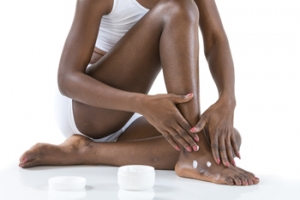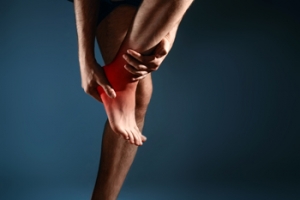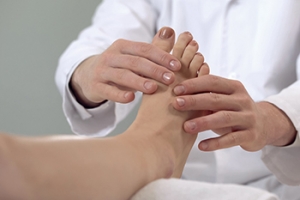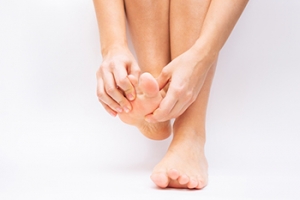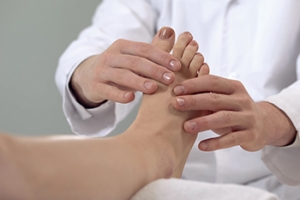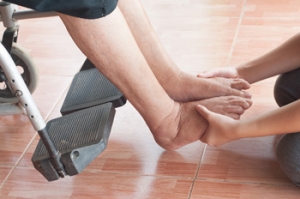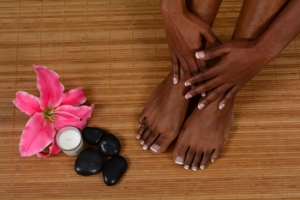Connect With Us
Blog
The Causes, Types, and Treatments of Achilles Tendon Injuries
Tendons are fibrous tissues that connect muscles with bone. The Achilles tendon is the largest tendon in the body. It connects the calf muscles at the back of the leg with the heel, and facilitates movements such as jumping, running, and walking.
Because the Achilles tendon is engaged so frequently and bears a great deal of pressure and stress throughout the day, it can become injured. Achilles tendon injuries cause the tissue to become irritated, inflamed, and swollen. Pain can come on gradually or be immediate, and will vary from mild to severe depending upon the injury. Where the pain occurs will vary as well, from just above the heel up through the back of the leg. There may also be stiffness in the tendon.
Achilles tendon injuries can often be caused by repetitive stress. They may also occur while running, playing tennis, gymnastics, football, basketball, dancing, soccer, baseball or other sports that require speeding up, slowing down, or pivoting quickly. Wearing high heels, falling from an elevation, stepping in a hole, having flat feet, bone spurs, tight leg muscles or tendons, wearing improper athletic shoes, exercising on uneven surfaces, or starting a new type of exercise can also cause Achilles tendon injuries.
The two most common Achilles tendon injuries are tendonitis and ruptures. Tendonitis causes painful inflammation and can occur in different parts of the tendon. Non-insertional Achilles tendonitis occurs when the fibers in middle of the tendon begin to break down, thicken, and swell. This condition typically affects younger, more active adults. Insertional Achilles tendonitis occurs where the tendon inserts into the heel bone. It is common for bone spurs to form with this type of injury. This condition can affect people of any age and level of activity.
Achilles tendon ruptures are a tear in the tendon. These breaks may be partial or complete. There may be an audible popping noise at the moment of injury and the pain will be sudden and severe.
An Achilles tendon injury can be diagnosed by your podiatrist after they examine you, check your range of motion, and possibly perform a calf squeeze test or review an X-ray or MRI. Depending on the type and severity of your injury, your podiatrist may treat your condition with rest/ice/compression/elevation (RICE), nonsteroidal anti-inflammatory medications, heel lifts, and stretching and strengthening exercises. If you have torn your Achilles tendon, treatment may include physical therapy, ultrasound, shockwave therapy, or possibly even surgery.
Practicing Everyday Foot Care Is Beneficial

Everyday foot care practice is simple to follow. The benefits outweigh the amount of time it takes to have healthy feet, and many unwanted foot conditions may be avoided. It can begin by washing and drying the feet thoroughly, followed by applying a good moisturizer on them. Properly trimming the toenails may prevent an ingrown toenail from developing, which often requires expert medical attention. One of the most important things you can do for your feet is to wear shoes and socks that are comfortable. This may be helpful in preventing corns, bunions, and hammertoe from developing. Many people enjoy practicing foot exercises and stretches, and strong feet may help to prevent falling episodes. Depending on the specific foot condition, research has shown that pain may be relieved by having regular foot massages performed, and may invoke a feeling of well-being throughout the body. If you would like more information about how to practice everyday foot care tips, please consult with a podiatrist.
Everyday foot care is very important to prevent infection and other foot ailments. If you need your feet checked, contact Daniel Bell, DPM from Florida. Our doctor can provide the care you need to keep you pain-free and on your feet.
Everyday Foot Care
Often, people take care of their bodies, face and hair more so than they do for their feet. But the feet are a very important aspect of our bodies, and one that we should pay more attention to. Without our feet, we would not be able to perform most daily tasks.
It is best to check your feet regularly to make sure there are no new bruises or cuts that you may not have noticed before. For dry feet, moisturizer can easily be a remedy and can be applied as often as necessary to the affected areas. Wearing shoes that fit well can also help you maintain good foot health, as well as making it easier to walk and do daily activities without the stress or pain of ill-fitting shoes, high heels, or even flip flops. Wearing clean socks with closed shoes is important to ensure that sweat and bacteria do not accumulate within the shoe. Clean socks help to prevent Athlete’s foot, fungi problems, bad odors, and can absorb sweat.
If you have any questions please feel free to contact our office located in Pembroke Pines and Plantation, FL . We offer the newest diagnostic and treatment technologies for all your foot and ankle needs.
Foot Pain Is Common Among Runners

There are many people who enjoy running that experience foot pain. Running causes the feet to endure repetitive stress as a result of the constant pounding on different types of surfaces. Research has indicated the most common types of foot pain caused by running injuries fall into four categories: plantar fasciitis, stress fractures, extensor tendonitis, and adductor and abductor hallucis. The plantar fascia is a band of tissue that runs along the sole of the foot. The majority of runners are familiar with pain that can come from an inflamed plantar fascia, known as plantar fasciitis. When this occurs, the heel pain this ailment brings can make running become difficult to pursue. A stress fracture can develop gradually, and may come from not warming up and cooling down properly. It is defined as a hairline fracture in one of the several bones in the feet, and rest is often needed for healing. Extensor tendonitis involves the tendons in the toes, and wearing shoes that do not fit correctly may cause these tendons to become inflamed. Adductor and abductor hallucis is a condition that affects the arch, and can occur from having inadequate arch support in the shoes. If you have foot pain of any kind, please consult with a podiatrist who can effectively diagnose problems and provide treatment.
Foot Pain
Foot pain can be extremely painful and debilitating. If you have a foot pain, consult with Daniel Bell, DPM from Florida. Our doctor will assess your condition and provide you with quality foot and ankle treatment.
Causes
Foot pain is a very broad condition that could be caused by one or more ailments. The most common include:
- Bunions
- Hammertoes
- Plantar Fasciitis
- Bone Spurs
- Corns
- Tarsal Tunnel Syndrome
- Ingrown Toenails
- Arthritis (such as Gout, Rheumatoid, and Osteoarthritis)
- Flat Feet
- Injury (from stress fractures, broken toe, foot, ankle, Achilles tendon ruptures, and sprains)
- And more
Diagnosis
To figure out the cause of foot pain, podiatrists utilize several different methods. This can range from simple visual inspections and sensation tests to X-rays and MRI scans. Prior medical history, family medical history, and any recent physical traumatic events will all be taken into consideration for a proper diagnosis.
Treatment
Treatment depends upon the cause of the foot pain. Whether it is resting, staying off the foot, or having surgery; podiatrists have a number of treatment options available for foot pain.
If you have any questions, please feel free to contact our office located in Pembroke Pines and Plantation, FL . We offer the newest diagnostic and treatment technologies for all your foot care needs.
Treating Bunions

Bunions are a common affliction of the foot where a bony bump develops on the side of the big toe. This causes the top of the big toe to point towards the second toe, and the structure of the big toe’s bones can be manipulated. A medical professional, such as a podiatrist (a foot specialist), may recommend to you several different treatment options for your bunions short of a surgical procedure. For instance, it might be recommended to take nonsteroidal anti-inflammatory medications to minimize inflammation. Also, a podiatrist might recommend avoiding physical activities that exacerbate symptoms of bunions or wearing footwear that provides more space in the toe box area. Lastly, a podiatrist may recommend applying an ice pack to your bunions several times a day to reduce inflammation. Contact a podiatrist today if you have a case of bunions.
If you are suffering from bunions, contact Daniel Bell, DPM of Florida. Our doctor can provide the care you need to keep you pain-free and on your feet.
What Is a Bunion?
A bunion is formed of swollen tissue or an enlargement of boney growth, usually located at the base joint of the toe that connects to the foot. The swelling occurs due to the bones in the big toe shifting inward, which impacts the other toes of the foot. This causes the area around the base of the big toe to become inflamed and painful.
Why Do Bunions Form?
Genetics – Susceptibility to bunions are often hereditary
Stress on the feet – Poorly fitted and uncomfortable footwear that places stress on feet, such as heels, can worsen existing bunions
How Are Bunions Diagnosed?
Doctors often perform two tests – blood tests and x-rays – when trying to diagnose bunions, especially in the early stages of development. Blood tests help determine if the foot pain is being caused by something else, such as arthritis, while x-rays provide a clear picture of your bone structure to your doctor.
How Are Bunions Treated?
- Refrain from wearing heels or similar shoes that cause discomfort
- Select wider shoes that can provide more comfort and reduce pain
- Anti-inflammatory and pain management drugs
- Orthotics or foot inserts
- Surgery
If you have any questions, please feel free to contact our office located in Pembroke Pines and Plantation, FL . We offer the newest diagnostic and treatment technologies for all your foot care needs.
Bunions
A bunion is a bump that forms at the base of the big toe. Bunions form when the big toe pushes against the next toe, which forces the big toe joint to get bigger and stick out. As a result, the skin over the bunion may start to appear red and it may feel sore.
There are risk factors that can increase your chances of developing bunions. People who wear high heels or ill-fitting shoes are more likely to develop them, in addition to those who have a genetic history of bunions or have rheumatoid arthritis.
The most obvious way to tell if you have a bunion is to look for the big toe pushing up against the toe next to it. Bunions produce a large protrusion at the base of the big toe and may or may not cause pain. Other symptoms are redness, swelling, and restricted movement of the big toe if you have arthritis.
Nonsurgical methods are frequently used to treat bunions that aren’t severe. Some methods of nonsurgical treatment are orthotics, icing and resting the foot, taping the foot, and pain medication. Surgery is usually only required in extreme cases. However, if surgery is needed, some procedures may involve removing the swollen tissue from around the big toe joint, straightening the big toe by removing part of the bone, or joining the bones of your affected joint permanently.
Your podiatrist will diagnose your bunion by doing a thorough examination of your foot. He or she may also conduct an x-ray to determine the cause of the bunion and its severity.
Why Toe Pain Occurs

The function of the big toe is to provide and maintain balance while daily activities are completed. The big toe is also essential for participating in running and jumping activities. Many people can get pain in their big toe and this can happen for a variety of reasons. Arthritis is a condition that can cause pain in this toe, affecting the joints. In severe cases, arthritis can be crippling and may cause difficulties in walking. People who enjoy running may be prone to gradually developing arthritis in the toe and this may be accompanied by swelling and stiffness. Gout can also cause debilitating pain in the joints of the big toe. It can occur for genetic reasons or from eating foods that have high levels of purines, causing an elevation in uric levels. This can cause crystals to form in the joints of the big toe and it is often difficult to walk. Extensor tendonitis can develop from having tight calf muscles and arthritis that affects the joints. If you have toe pain for any reason, it is strongly advised that you seek the counsel of a podiatrist who can determine what the cause is and treat it accordingly.
Toe pain can disrupt your daily activities. If you have any concerns, contact Daniel Bell, DPM of Florida. Our doctor can provide the care you need to keep you pain-free and on your feet.
What Causes Toe Pain?
Most severe toe pain is caused due to a sports injury, trauma from dropping something heavy on the toe, or bumping into something rigid. Other problems can develop over time for various reasons.
Toe pain can be caused by one or more ailments. The most common include:
- Trauma
- Sports injury
- Wearing shoes that are too tight
- Arthritis
- Gout
- Corns and calluses
- Hammertoe
- Bunions
- Blisters
- Ingrown toenails
- Sprains
- Fractures (broken bones)
- Dislocations
When to See a Podiatrist
- Severe pain
- Persistent pain that lasts more than a week
- Signs of infection
- Continued swelling
- Pain that prevents walking
Diagnosis
In many cases the cause of toe pain is obvious, but in others, a podiatrist may want to use more advanced methods to determine the problem. These can range from simple visual inspections and sensation tests to X-rays and MRI scans. Prior medical history, family medical history, and any recent physical traumatic events will all be taken into consideration for a proper diagnosis.
Treatment
Treatments for toe pain and injuries vary and may include shoe inserts, padding, taping, medicines, injections, and in some cases, surgery. If you believe that you have broken a toe, please see a podiatrist as soon as possible.
If you have any questions please feel free to contact our office located in Pembroke Pines and Plantation, FL . We offer the newest diagnostic tools and technology to treat your foot and ankle needs.
How Your Diet Can Contribute to Gout

Gout is a form of arthritis that occurs when crystals formed by uric acid cause painful inflammation in the joints, commonly the big toe. People typically develop gout because their body does not efficiently flush out excess uric acid through the kidneys. Certain foods contribute to the onset of gout. The top contenders are certain types of meat and seafood. In addition, alcoholic beverages like beer and sugary drinks can contribute to gout. Foods that are high in cholesterol are also believed to increase the risk of developing gout. Eating foods high in purines is not the only way to build up too much uric acid, called hyperuricemia. Poor kidney function is thought to be a factor too. If you are experiencing pain in the joint of the big toe along with redness and swelling, you may have gout. It is suggested that you contact a podiatrist who can examine the area, diagnose the cause, and offer treatment solutions.
Gout is a foot condition that requires certain treatment and care. If you are seeking treatment, contact Daniel Bell, DPM from Florida. Our doctor will treat your foot and ankle needs.
What Is Gout?
Gout is a type of arthritis caused by a buildup of uric acid in the bloodstream. It often develops in the foot, especially the big toe area, although it can manifest in other parts of the body as well. Gout can make walking and standing very painful and is especially common in diabetics and the obese.
People typically get gout because of a poor diet. Genetic predisposition is also a factor. The children of parents who have had gout frequently have a chance of developing it themselves.
Gout can easily be identified by redness and inflammation of the big toe and the surrounding areas of the foot. Other symptoms include extreme fatigue, joint pain, and running high fevers. Sometimes corticosteroid drugs can be prescribed to treat gout, but the best way to combat this disease is to get more exercise and eat a better diet.
If you have any questions please feel free to contact our office located in Pembroke Pines and Plantation, FL . We offer the newest diagnostic and treatment technologies for all your foot and ankle needs.
Feet Problems in the Elderly

The foot can be compared to a tire of a car. After many years of use, a foot can wear down like tires wear down. A tire becomes thin and the tread less dependable over time just as a human foot shows its age over time. The key difference between a foot and a tire is the former cannot be changed. We get one pair of feet per life. Because seniors are generally less active than those younger, they may not pay as much attention to their feet as they once did. But as one ages, they need to pay even more attention to their feet. If you are a senior you will likely experience foot pain. And foot pain is highly associated with a higher risk of recurrent falls, reduced mobility, and a loss of independence. Muscles and tendons lose elasticity with age and that contributes to pain. Additionally elderly foot pain is a result of putting on weight, losing fat on the padding of feet, compromised blood flow from health problems (such as diabetes or peripheral neuropathy), persistent foot problems, such as hammertoes, bunions, corns, calluses, wearing shoes that do not fit well, or simple neglect in care. Daily foot inspections, washing, drying, and moisturizing feet frequently, and cutting toenails straight across are all part of a good foot care routine. Paying attention to diet, exercising, and wearing properly fitted shoes and socks will all help in alleviating foot problems as well. If you are a senior or responsible for caring for a senior, include a podiatrist on the health care team to teach you how to care for your feet or provide diagnosis and treatment should a problem arise.
Proper foot care is something many older adults forget to consider. If you have any concerns about your feet and ankles, contact Daniel Bell, DPM from Florida. Our doctor can provide the care you need to keep you pain-free and on your feet.
The Elderly and Their Feet
As we age we start to notice many changes in our body, but the elder population may not notice them right away. Medical conditions may prevent the elderly to take notice of their foot health right away. Poor vision is a lead contributor to not taking action for the elderly.
Common Conditions
- Neuropathy – can reduce feeling in the feet and can hide many life-threatening medical conditions.
- Reduced flexibility – prevents the ability of proper toenail trimming, and foot cleaning. If left untreated, it may lead to further medical issues.
- Foot sores – amongst the older population can be serious before they are discovered. Some of the problematic conditions they may face are:
- Gouging toenails affecting nearby toe
- Shoes that don’t fit properly
- Pressure sores
- Loss of circulation in legs & feet
- Edema & swelling of feet and ankles
Susceptible Infections
Diabetes and poor circulation can cause general loss of sensitivity over the years, turning a simple cut into a serious issue.
If you have any questions please feel free to contact our office located in Pembroke Pines and Plantation, FL . We offer the newest diagnostic and treatment technologies for all your foot and ankle needs.
Elderly Foot Care
As you grow older, you will start to notice more problems with your feet due to wear and tear. This may also happen because the skin will start to become thin and lose elasticity. Some signs of aging feet are regular aches and pains, bunion development, and clawed toes.
Fortunately, there are ways you can improve comfort, relieve pain, and maintain mobility in your feet. One of the best ways to deal with aging feet is to exercise. If you keep active, your muscles will become toned which will then strengthen the arches in the foot and stimulate blood circulation.
It is important that you practice proper foot care to protect your aging feet. You should wash your feet in warm water on an everyday basis. Afterward, the feet need to be dried well and it is important to dry between the toes. Your toenails should be trimmed and kept under control; nails that are poorly cut may become ingrown. At the end of each day, performing an inspection of your feet will allow you to detect any ailments in their early stages.
As you grow older, it becomes more important that you wear comfortable shoes. Your shoes should be secure, and they should provide decent arch support. If you are looking to buy a new pair of shoes, it is best to look for a pair that are made from a breathable material. It is also helpful to have shoes that have a bit of extra room at the top of the shoe, especially if you suffer from swollen feet.
The most common foot problems that elderly people will encounter are bunions, calluses, corns, hammertoes, heel pain, and foot problems related to diabetes. Some other issues include arch pain, tarsal tunnel syndrome, Achilles tendonitis, and Morton’s neuroma
An annual foot examination is a great way for you to ensure that you do not have any serious health problems with your feet. You should talk to a podiatrist about the available treatment options for whichever foot issue you are dealing with.
Benefits of Following a Regular Foot Care Routine

We can go to professional salons to have our feet pampered but that can be costly. If you want to indulge your feet more often, you can follow a foot care routine in the comfort of your home which will be much cheaper. While we depend on our feet to get us around and hold us up for a lifetime, we tend to neglect them compared to the skin on our faces. Ignoring foot care can come with the risk of infections, corns, cracked heels, sore feet, blisters, and foot odor. Regular foot care includes examining your feet regularly to see if you have cuts, bruises, or inflammation. It also includes washing and drying feet daily, applying a moisturizer, and trimming the toenails properly by cutting them straight across and using a nail file to round the edges. Well-fitting shoes and socks must be worn too. If you notice your feet are hard and dry, you can soften the skin by soaking them in hot water and using Epsom salt as an exfoliator. If you have questions about how to properly care for your feet or if you sustain an injury, consult with a podiatrist who can answer any questions as well as provide a diagnosis and treatment plan.
Everyday foot care is very important to prevent infection and other foot ailments. If you need your feet checked, contact Daniel Bell, DPM from Florida. Our doctor can provide the care you need to keep you pain-free and on your feet.
Everyday Foot Care
Often, people take care of their bodies, face and hair more so than they do for their feet. But the feet are a very important aspect of our bodies, and one that we should pay more attention to. Without our feet, we would not be able to perform most daily tasks.
It is best to check your feet regularly to make sure there are no new bruises or cuts that you may not have noticed before. For dry feet, moisturizer can easily be a remedy and can be applied as often as necessary to the affected areas. Wearing shoes that fit well can also help you maintain good foot health, as well as making it easier to walk and do daily activities without the stress or pain of ill-fitting shoes, high heels, or even flip flops. Wearing clean socks with closed shoes is important to ensure that sweat and bacteria do not accumulate within the shoe. Clean socks help to prevent Athlete’s foot, fungi problems, bad odors, and can absorb sweat.
If you have any questions please feel free to contact our office located in Pembroke Pines and Plantation, FL . We offer the newest diagnostic and treatment technologies for all your foot and ankle needs.
Blog Archives
- April 2025
- March 2025
- February 2025
- January 2025
- December 2024
- November 2024
- October 2024
- September 2024
- August 2024
- July 2024
- June 2024
- May 2024
- April 2024
- March 2024
- February 2024
- January 2024
- December 2023
- November 2023
- October 2023
- September 2023
- August 2023
- July 2023
- June 2023
- May 2023
- April 2023
- March 2023
- February 2023
- January 2023
- December 2022
- November 2022
- October 2022
- September 2022
- August 2022
- July 2022
- June 2022
- May 2022
- April 2022
- March 2022
- February 2022
- January 2022
- December 2021
- November 2021
